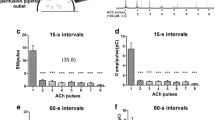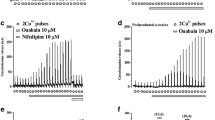Abstract
Effects of cholinergic and adrenergic agonists on the secretion of the fluorescent dye calcein were examined to clarify the involvement of calcium ions in the secretion of calcein from acinar cells dispersed from the rat parotid gland. Addition of carbachol (CCh) and noradrenalin (NA), but not isoproterenol (IPR), enhanced the net release of calcein from acinar cells during the subsequent 10 min in a dose range from 10−8 M to 10−6 M. The net release of calcein reached a maximum 7 min after the addition of CCh. The release of calcein was suppressed by the simultaneous additions of atropine with CCh, or phenoxybenzamine with NA. Addition of CCh induced a sustained dosedependent increase in the intracellular levels of calcium ions, ([Ca2+]i). Addition of NA at 10−6 M increased [Ca2+]i. Phenoxybenzamine completely inhibited the NA-induced increase, but propranolol did not. The removal of extracellular calcium ions did not influence the release of calcein induced by 10−6 M CCh, but it abolished the sustained increase in [Ca2+]i. The transient increase in [Ca2+]i induced by CCh was observed in the absence of extracellular calcium ions. A calcium ion chelator, 1,2-bis(2-aminophenoxy)ethane-N,N,N′,N′-tetraacetic acid (BAPTA) inhibited the CCh-induced release of calcein. The calcium ionophore, A23187 (2.5×10−6 M), but not 10−3 M dibutyryl cAMP, evoked the release of calcein. It also increased [Ca2+]i. Removal of extracellular calcium ions suppressed the A23187-induced release of calcein. These results suggest that the release of calcein from parotid acinar cells is transiently induced through an increase in [Ca2+]i by muscarinic and α-adrenergic agonists and may represent the initial process of salivary secretion.
Similar content being viewed by others
References
Baum BJ (1987) Neurotransmitter control of secretion. J Dent Res 66:628–632
Bernfeld P (1955) Amylases, alpha and beta. In: Colowick SP, Kaplan NO (eds) Methods in enzymology, vol 1. Academic, New York, pp 149–158
Case RM, Conigrave AD, Novak I, Young JA (1980) Electrolyte and protein secretion by the perfused rabbit mandibular gland stimulated with acetylcholine or catecholamines. J Physiol (Lond) 300:467–487
Cook DI, Young JA (1990) Cation channels and secretion. In: Young JA, Wong PYD (eds) Epithelial secretion of water and electrolytes. Springer, Berlin Heidelberg New York, pp 15–38
Dissing S, Nauntofte B, Sten-Knudsen O (1990) Spatial distribution of intracellular, free Ca2+ in isolated rat parotid acini. Pflügers Arch 417:1–12
Foskett JK (1985) NBD-taurine fluorescence as a probe of anion exchange in gallbladder epithelium. Am J Physiol 249:C56-C62
Foskett JK, Melvin JE (1989) Activation of salivary secretion coupling of cell volume and [Ca2+]i in single cells. Science 30:1582–1585
Kawasaki Y, Saitoh T, Okabe T, Kumakura K, Ohara-Imaizumi M (1991) Visualization of exocytotic secretory process of mast cells by fluorescence techniques. Biochim Biophys Acta 1067:71–80
Marty A (1991) Calcium release and internal calcium regulation in acinar cells of exocrine glands. J Membr Biol 124:189–197
Melvin JE, Turner RJ (1992) Cl− fluxes related to fluid secretion by the rat parotid: involvement of C1−-HCO3 − exchange. Am J Physiol 262:G393-G398
Melvin JE, Kawaguchi M, Baum BJ, Turner RJ (1987) A muscarinic agonist-stimulated chloride efflux is associated with fluid secretion in rat parotid acinar cells. Biochem Biophys Res Commun 145:754–759
Merritt JE, Rink TJ (1987) Regulation of cytosolic free calcium in fura-2-loaded rat parotid acinar cells. J Biol Chem 262:17362–17369
Nakahari T, Murakami M, Yoshida H, Miyamoto M, Sohma Y, Imai Y (1990) Decrease in rat submandibular acinar cell volume during ACh stimulation. Am J Physiol 258:G878-G886
Nauntofte B (1992) Regulation of electrolyte and fluid secretion in salivary acinar cells. Am J Physiol 263:G823-G837
Petersen OH (1992) Stimulus-secretion coupling: cytoplasmic calcium signals and the control of ion channels in exocrine acinar cells. J Physiol (Lond) 448:1–54
Putney JW, Bird GJ (1993) The signal for capacitative calcium entry. Cell 75:199–201
Quissell DO, Watson E, Dowd FJ (1992) Signal transduction mechanisms involved in salivary gland regulated exocytosis. Crit Rev Oral Biol Med 3:83–107
Sasaki Y, Shiba Y, Kanno Y (1988) Suppression of intercellular communication in acinar cells from rat submandibular gland by cholinergic and adrenergic agonists. Jpn J Physiol 38:531–543
Segawa A, Terakawa S, Yamashina S, Hopkins CR (1991) Exocytosis in living salivary glands: direct visualization by video enhanced microscopy and confocal laser microscopy. Eur J Cell Biol 54:322–330
Shiba Y, Sugita M, Hirono C, Sasaki Y, Kanno Y (1992) Salivary secretion and gap-junction permeability in the rat submandibular gland. In: Murakami M, Seo Y, Ishikawa T (eds) Salivary secretion control and mechanisms. National Institute for Physiological Sciences, Okazaki, Japan, pp 41–44
Takemura H (1985) Changes in cytosolic free calcium concentration in isolated rat parotid cells by cholinergic and betaadrenergic agonist. Biochem Biophys Res Commun 131:1048–1055
Williams JA, Korc M, Dormer RL (1978) Action of secretagogues on a new preparation of functionally intact, isolated pancreatic acini. Am J Physiol 235:E517-E524
Author information
Authors and Affiliations
Rights and permissions
About this article
Cite this article
Sugita, M., Shiba, Y., Furuya, K. et al. Involvement of intracellular calcium ions in the release of the fluorescent dye calcein by cholinergic and α-adrenergic agonists from rat parotid acinar cells. Pflügers Arch. 429, 555–560 (1995). https://doi.org/10.1007/BF00704161
Received:
Revised:
Accepted:
Issue Date:
DOI: https://doi.org/10.1007/BF00704161




